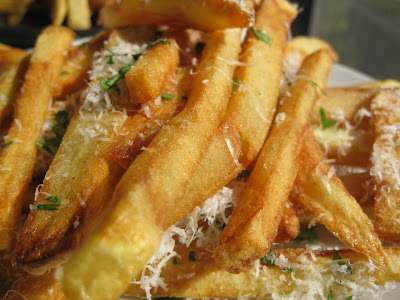You know, when I said butternut squash was encroaching on tater’s territory, I was just joshin’. I mean really, there can only be one supreme ruler of my vegetable world, and that distinction remains firmly in the potato’s starchy grasp. I think its humble elegance is what grabs me. So rarely does the potato shine as the entrée. French fries, for example, are an everyday food, almost ignored and usually relegated to the label “side dish”. It is pushed aside by so many, yet still beloved and worthy of center plate. However, all one needs to do is change the label to “pomme frite” (or for that matter, add any French word like Dauphinois, puree, Lyonnaise, etc.) and it is elevated to haute cuisine. People will ooh and ahh and fall all over themselves to tell you about their Belgian experience with the perfect fry. They’re memorable, and your homemade pomme frite will be just as good.
In pursuit of the perfect French fry you endure a few more steps than you’re used to. Step one, turn your back on the freezer isle. I know frozen fries are easy, and there are good brands out there, but none of them will ever be as good as a home cut, freshly fried potato.
The Potato
Buy russet potatoes, the humblest potato of them all. Those little fingerlings are too waxy, and as delicious as Yukon golds are, they face the same waxy fate. You want something super starchy and fluffy – the starchiest and fluffiest out there is the Idaho russet.
Now slice the potato in finger size batons at least an hour in advance, peel the potato if you wish, but the peel won’t hurt the result or you (yay for nutrients!). Leave the batons in cold water to cover until you’re ready to fry them. This will wash away the excess starch on the outside that could hinder the browning and general deliciousness. But beware, water and hot shimmering oil do not mix. Dry them off thoroughly with a towel and/or salad spinner before depositing in the oil.
The Oil
Use a light oil like peanut, vegetable, or canola. Peanut tastes the best in frying, but can be a bit pricer than the others. I confess to using canola most of the time. It’s heart healthy, cheap, and has a high smoke point. You MUST have a thermometer that can withstand temperatures of at least 400F. I like the digital thermometers that you can set to a certain goal temperature. That way you can set it, leave it in the oil, and it will beep when the oil is at the correct temperature. Just be sure to not let the thermometer touch the bottom/sides for accurate readings.
The Method
Pour the oil into a deep, heavy pot large enough so that it comes no more than halfway up its sides, and heat to 320˚F, or until a potato stick dropped into the oil sinks to the bottom of the pot and then rises to the surface (I usually heat the oil to 330F initially so the temperature will recover to 320F faster). Add a handful of the potatoes and fry for about 10 minutes, or until cooked through but not browned. If the potatoes start to brown, reduce the heat slightly. Using a spider or skimmer, remove the potatoes from the oil and put them on a sheet pan/plate (not paper towels or it will stick), Continue to fry the remaining potatoes in batches.
Increase the temperature of the oil to 365˚F. Add a handful of the potatoes and fry for 1 to 2 minutes, or until golden brown. Using a spider or skimmer, transfer the potatoes to paper towels to drain briefly. Continue to fry the remaining potatoes in batches and allow the temperature to recover after each batch. Sprinkle with salt/toppings and serve immediately. If you want to keep them warm and crispy, you can do so in a 225F oven for about 15 minutes before they get soggy.
Topping Ideas
I made two kinds of fries:
Truffle salt, grated white Oregon truffles, and black pepper
Parmigiano Reggiano, kosher salt, and parsley
Here are other serving ideas:
- Smoked paprika and lemon zest
- Fresh thyme, gruyere cheese sauce (make a béchamel and slowly melt gruyere + Dijon mustard into it), sliced French madrange ham, and minced shallot broiled for a take on the famous Croque Madame sandwich
- Toss with a compound herb butter
- Serve with garlic confit aioli (see future posts)
- Toss with harissa, or make harissa aioli/ketchup
- Serve with bagna cauda (anchovy sauce)
- Make a classic Ranch dressing at home to serve on the side: Mix together: 1/2 cup mayonnaise + 1/2 cup sour cream + 1 tablespoon white wine vinegar + 2 tablespoons chopped fresh dill + 1 teaspoon granulated garlic or 1 clove finely chopped garlic + kosher salt and fresh cracked black pepper, flavors will mature and be even better later but it’s fine to eat it right away
My grade: B+ (based on Robert's assessment, I would give an A, but I'm biased with potatoes)
Recipe grade: A- (you will have to figure out how dark the fries should be for your tastes)
Diagnosis: Good, but I wish this method worked for sweet potatoes too.


















